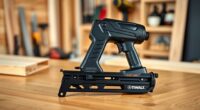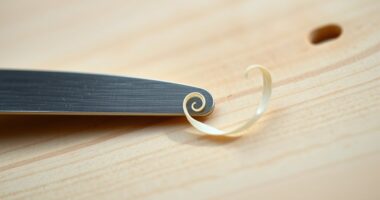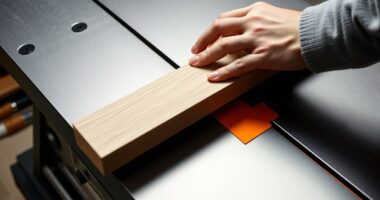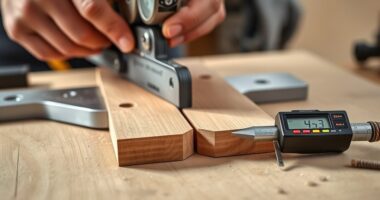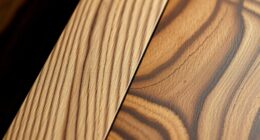To tune your bandsaw for resawing thick stock, start by making sure the blade sits straight in the guides and tracks properly on the wheels. Adjust the guide blocks so they’re close but not touching during operation. Check and set the blade tension using the saw’s tension gauge or deflection method. Proper alignment and tension prevent blade wobble, reduce wear, and ensure smooth cuts. Keep tuning and inspecting your saw—it’s key to achieving clean, precise results every time.
Key Takeaways
- Ensure the blade is properly aligned with guides and wheels using a straightedge or alignment gauge.
- Adjust blade tension according to the manufacturer’s recommended range, checking for proper deflection and tracking.
- Verify the blade runs true in guides and wheels, making fine adjustments to prevent wobble during cuts.
- Recheck and fine-tune blade alignment and tension after any adjustments to maintain optimal performance.
- Regularly inspect and maintain your bandsaw to ensure consistent tension and alignment for clean, accurate resawing of thick stock.

Tuning your bandsaw is essential for achieving smooth, accurate cuts and extending the tool’s lifespan. When you’re resawing thick stock, precision matters more than ever, and proper setup can make all the difference. The first step is to focus on blade alignment. You want the blade to sit perfectly straight in the guides and align with the wheels. Misalignment causes uneven cuts, blade wobble, and increased wear. To check this, turn off the saw, loosen the blade tension, and manually position the blade so it runs true in the guides and against the wheels. Use a straightedge or a blade alignment gauge to verify that the blade tracks centrally on the wheels and runs parallel to the table. Adjust the guide blocks if needed, making sure they’re close but not touching the blade during operation. Proper blade alignment is key to maintaining consistent tension and ensuring the blade cuts smoothly through thick material. In addition, ensuring the correct projector setup can help you monitor your progress and detect any misalignments during the process.
Next, tension adjustment plays a critical role. The right tension keeps the blade stable and prevents it from wandering or breaking under strain. Too loose, and the blade can wobble or bind; too tight, and it risks damaging the blade or the saw’s components. To set the tension, consult your bandsaw’s manual for the recommended tension range based on your blade width and thickness. Typically, you can gauge tension by observing the blade’s deflection—when plucked, it should produce a clear, sharp tone, not a dull one. Use the tensioning wheel or knob to achieve this, tightening or loosening incrementally. After adjusting, spin the wheel by hand to feel for smoothness and to check that the blade is properly seated and tracking well. Once you’ve adjusted the tension, double-check the blade alignment—since tension can sometimes shift the blade position.
As you fine-tune your bandsaw, remember that these adjustments work together: proper blade alignment ensures the blade tracks correctly, and the right tension keeps it stable during cuts. Regularly inspecting and maintaining these settings before each resaw session will help you produce cleaner, more precise cuts on thick stock. Keep in mind, a well-tuned bandsaw not only improves your work but also reduces the risk of blades breaking or other mechanical issues. With patience and careful adjustments, you’ll find that your resawing becomes easier, faster, and more accurate, making your woodworking projects much more successful.
Frequently Asked Questions
How Often Should I Check Blade Tension During Resawing?
You should check your blade tension frequently during resawing, especially when working with thick stock. Proper blade maintenance and consistent machine calibration are key to achieving clean cuts. Check tension every 15-20 minutes or whenever you notice the cut becoming rough or the blade wandering. Regular adjustments ensure your bandsaw runs smoothly, reduces wear, and keeps your resawing precise. Staying attentive to tension helps maintain ideal performance throughout your project.
What Is the Ideal Blade Tension for Thick Stock?
For thick stock, the ideal blade tension depends on your blade selection and the material’s density. You should tighten the blade enough to prevent it from deflecting or slipping during cuts, but not so tight that it causes excessive wear or stress. Adjust tension gradually, checking for consistent tracking, and always follow your saw manufacturer’s recommendations for tension adjustment, especially when working with thicker, denser materials.
How Do I Tell if My Blade Is Dull?
You notice uneven cuts or excessive blade noise, and suddenly realize your blade might be dull. Dullness signs include increased effort to push through the wood, burn marks, or rough, splintered surfaces. If your blade’s blade sharpness appears compromised despite proper tension, it’s time to replace it. Regularly check for dullness signs to ensure smooth resawing, and keep your bandsaw performing at its best.
Can I Use a Different Blade Type for Resawing?
Yes, you can use different blade types for resawing, but choosing the right blade is key. Your blade selection impacts cut quality and efficiency, so consider alternative blades like those with more teeth for smoother cuts or wider blades for stability. Always match the blade type to your material and resawing needs, ensuring it’s compatible with your bandsaw for ideal results.
What’s the Best Way to Prevent Blade Drift?
Think of blade drift like a boat veering off course; you need steady hands to keep it straight. To prevent this on your bandsaw, confirm your blade guides are properly adjusted and snug, providing firm support. Also, double-check your fence alignment regularly. When guides are tight and the fence is aligned, you’re more likely to saw straight, avoiding drift and achieving clean, accurate cuts.
Conclusion
So, after all that tuning, you’d think your bandsaw would be a perfect resawing machine, right? Turns out, even the best setup isn’t foolproof—sometimes, you’ll still wrestle with a wandering blade or uneven cuts. But hey, isn’t that part of the charm? Just remember: no matter how much you tweak, a little patience and a sense of humor will always be your best tools. Happy resawing—success might just be a cut or two away!

